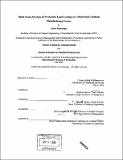| dc.contributor.advisor | Stephen Graves and Gregory McRae. | en_US |
| dc.contributor.author | Mazariegos, Carlos | en_US |
| dc.contributor.other | Leaders for Manufacturing Program. | en_US |
| dc.date.accessioned | 2006-11-08T16:47:31Z | |
| dc.date.available | 2006-11-08T16:47:31Z | |
| dc.date.copyright | 2005 | en_US |
| dc.date.issued | 2005 | en_US |
| dc.identifier.uri | http://hdl.handle.net/1721.1/34842 | |
| dc.description | Thesis (M.B.A.)--Massachusetts Institute of Technology, Sloan School of Management; and, (S.M.)--Massachusetts Institute of Technology, Dept. of Chemical Engineering; in conjunction with the Leaders for Manufacturing Program at MIT, 2005. | en_US |
| dc.description | Includes bibliographical references (p. 111). | en_US |
| dc.description.abstract | In the last couple of years Eastman Kodak Company went through major changes in its strategic direction. The same disruptive technologies that they helped develop for digital imaging have shaped a new industry, and the market requirements and preferences for photography have changed dramatically. Some of the tightly held complementary assets that gave Kodak a competitive advantage are no longer as critical as were in the past. Kodak management has set a very strong emphasis on running a lean operation. At the same time, executive management has set very aggressive targets for inventory reduction and productivity increase in the manufacturing units. Demand for chemicals used in film and paper for silver halide-based photography has steadily decreased in the last decade. There is growing pressure to increase inventory turns in production processes that are not as profitable as they were ten to twenty years ago. Management is faced with the need to implement aggressive tactics that minimize inventories and lower costs. Continuous batch size reduction is one of the lean manufacturing principles that manufacturers of discrete parts have successfully used to drive operational improvements and that Kodak is pursuing as well. This thesis takes a closer look at the differences between discrete and batch chemical manufacturers. It describes the considerations and real challenges in analyzing batch sizing decisions for chemical plants that have been operating for several years. In general, for Kodak's chemical manufacturing processes, large batches are needed to reduce total manufacturing costs. | en_US |
| dc.description.abstract | (cont.) These cases serve as an example for Kodak's management and lays out the steps that have to be taken to support the decision-making process. A tool to support batch sizing strategies that are aligned with inventory objectives is presented. The need for continuous revision of batch sizing policies in the face of declining demand in some products and increased growth in others is emphasized. Finally, the thesis touches upon the application of production load leveling and its potential benefit in a chemical plant. This concept that has been implemented in several forms within lean factories should be taken very seriously at the chemical plants of Eastman Kodak Company. The example of the work done for one high-volume chemical will support the conclusions on production load leveling. | en_US |
| dc.description.statementofresponsibility | by Carlos Mazariegos. | en_US |
| dc.format.extent | 117 p. | en_US |
| dc.format.extent | 6862879 bytes | |
| dc.format.extent | 6867744 bytes | |
| dc.format.mimetype | application/pdf | |
| dc.format.mimetype | application/pdf | |
| dc.language.iso | eng | en_US |
| dc.publisher | Massachusetts Institute of Technology | en_US |
| dc.rights | M.I.T. theses are protected by copyright. They may be viewed from this source for any purpose, but reproduction or distribution in any format is prohibited without written permission. See provided URL for inquiries about permission. | en_US |
| dc.rights.uri | http://dspace.mit.edu/handle/1721.1/7582 | |
| dc.subject | Sloan School of Management. | en_US |
| dc.subject | Chemical Engineering. | en_US |
| dc.subject | Leaders for Manufacturing Program. | en_US |
| dc.title | Batch sizing strategy & production load leveling in a multi-step chemical manufacturing process | en_US |
| dc.title.alternative | Batch sizing strategy and production load leveling in a multi-step chemical manufacturing process | en_US |
| dc.type | Thesis | en_US |
| dc.description.degree | S.M. | en_US |
| dc.description.degree | M.B.A. | en_US |
| dc.contributor.department | Leaders for Manufacturing Program at MIT | en_US |
| dc.contributor.department | Massachusetts Institute of Technology. Department of Chemical Engineering | |
| dc.contributor.department | Sloan School of Management | |
| dc.identifier.oclc | 63199278 | en_US |
